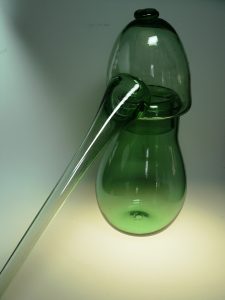Alembic - German/German

The advantages of glass for medical, chemical and scientific purposes were already known to the ancient alchemists: Glass is odourless, resistant to acids and alkalis, transparent and easy to clean. It is precisely these advantages that make glass an indispensable material for industry, technology and medicine today.
The alembic was once one of the most important tools of the alchemists. These first "chemists" were concerned with the production of gold and the transformation of base metals into gold and silver. To do this, they looked for a very specific tincture, which they called the "philosopher's stone". Today's chemists would call it a catalyst. Distillation, extraction and other apparatuses were indispensable tools in their various attempts at conversion. One of these distillation apparatuses was the "alembic", from the Arabic "al-anbiq", vessel or bowl. With it, substances could be separated from each other by heating and then cooling.
The invention of the "alembic" is attributed to the Arabs. They refined the distillation process, which was already known in antiquity, in the 9th or 10th century. They placed a helmet over the distillation flask with the essence to be distilled, in which there was a collecting channel inside. The condensate collected there before it flowed out of the pipe on the side into a collecting vessel. Originally, the name "Alembik" was only used for the distilling helmet. Over the years, the name was transferred to the entire apparatus: the distilling flask with the distilling helmet and the collecting bottle.
Alembic - English

Even alchemists from antiquity knew the advantages of glass for medicine, chemistry and the natural sciences: it is odourless, acid and alkali proof, transparent and easy to clean. And it is these properties that make glass an indispensable commodity for industry, technology and medicine today.
The alembic was once one of an alchemist's most important pieces of equipment. These early "chemists," were concerned with producing gold or transforming common metals into gold and silver. They were searching for a particular tincture, that they called "the philosopher's stone." Today, chemists would refer to it as a catalyst. In their numerous transformation attempts distillation, extraction and other types of apparatus were essential tools. The "Alembik", or "al-anbiq", in Arabian, meaning receptacle or bowl, was one such distillation apparatus. Substances could be heated in it and then cooled and separated.
The invention of the "Alembik" is attributed to the Arabs who refined the process of distillation, already used during antiquity, in the 9th or 10th century. They put a domed lid with an internal collection groove above the distillation flask containing the essence to be distilled where the condensate collected before it flowed out of a tube mounted on the side into a collection container. The name "Alembik" was originally used to describe the distillation lid only, but over the years the name has come to refer to the whole piece of apparatus: the distillation flask, domed lid and collection bottle.